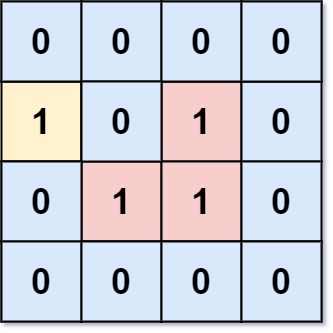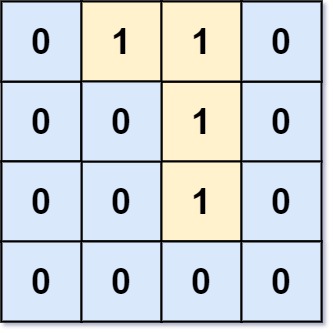Problem 1678. Goal Parser Interpretation
-
You own a Goal Parser that can interpret a string
command. Thecommandconsists of an alphabet of"G","()"and/or"(al)"in some order. The Goal Parser will interpret"G"as the string"G","()"as the string"o", and"(al)"as the string"al". The interpreted strings are then concatenated in the original order. -
Given the string
command, return the Goal Parser's interpretation ofcommand.
Examples
-
Example 1:
- Input: command = "G()(al)"
- Output: "Goal"
- Explanation: The Goal Parser interprets the command as follows:
- G -> G
- () -> o
- (al) -> al
- The final concatenated result is "Goal".
-
Example 2:
- Input: command = "G()()()()(al)"
- Output: "Gooooal"
-
Example 3:
- Input: command = "(al)G(al)()()G"
- Output: "alGalooG"
Constraints
1 <= command.length <= 100commandconsists of"G","()", and/or"(al)"in some order.
Solution
- for 문, join 메서드를 사용한 풀이
/**
* @param {string} command
* @return {string}
*/
var interpret = function(command) {
const strArr = [];
let str = '';
for (const letter of command) {
if (letter === 'G') {
strArr.push(letter);
str = '';
} else if (letter === '(') {
str = letter;
} else if (letter === ')') {
str += letter;
str = str.length > 2 ? 'al' : 'o';
strArr.push(str);
str = '';
} else {
str += letter;
}
}
return strArr.join('');
};- split, join 메서드를 사용한 풀이
/**
* @param {string} command
* @return {string}
*/
var interpret = function(command) {
return command.split('()').join('o').split('(al)').join('al');
};Problem 1020. Number of Enclaves
-
You are given an
m x nbinary matrixgrid, where0represents a sea cell and1represents a land cell. -
A move consists of walking from one land cell to another adjacent (4-directionally) land cell or walking off the boundary of the
grid. -
Return the number of land cells in grid for which we cannot walk off the boundary of the grid in any number of moves.
Examples
- Example 1:
- Input: grid = [[0,0,0,0],[1,0,1,0],[0,1,1,0],[0,0,0,0]]
- Output: 3
- Explanation: There are three 1s that are enclosed by 0s, and one 1 that is not enclosed because its on the boundary.

- Example 2:
- Input: grid = [[0,1,1,0],[0,0,1,0],[0,0,1,0],[0,0,0,0]]
- Output: 0
- Explanation: All 1s are either on the boundary or can reach the boundary.

Constraints
m == grid.lengthn == grid[i].length1 <= m, n <= 500grid[i][j]is either0or1.
Solution
/**
* @param {number[][]} grid
* @return {number}
*/
var numEnclaves = function(grid) {
const M = grid.length;
const N = grid[0].length;
const directions = [[-1, 0], [1, 0], [0, -1], [0, 1]];
const dfs = (x, y) => {
grid[x][y] = 0;
for (const [dx, dy] of directions) {
const nx = x + dx;
const ny = y + dy;
if (nx >= 0 && nx < M && ny >= 0 && ny < N && grid[nx][ny]) {
dfs(nx, ny);
}
}
}
for (let i = 0; i < M; i++) {
if (grid[i][0]) {
dfs(i, 0);
}
if (grid[i][N - 1]) {
dfs(i, N - 1);
}
}
for (let j = 0; j < N; j++) {
if (grid[0][j]) {
dfs(0, j);
}
if (grid[M - 1][j]) {
dfs(M - 1, j);
}
}
let landCount = 0;
for (let i = 0; i < M; i++) {
for (let j = 0; j < N; j++) {
if (grid[i][j]) {
landCount++;
}
}
}
return landCount;
};Problem 1021. Remove Outermost Parentheses
-
A valid parentheses string is either empty
"","(" + A + ")", orA + B, whereAandBare valid parentheses strings, and+represents string concatenation.- For example,
"","()","(())()", and"(()(()))"are all valid parentheses strings.
- For example,
-
A valid parentheses string s is primitive if it is nonempty, and there does not exist a way to split it into
s = A + B, withAandBnonempty valid parentheses strings. -
Given a valid parentheses string
s, consider its primitive decomposition:s = P1 + P2 + ... + Pk, where Pi are primitive valid parentheses strings. -
Return
safter removing the outermost parentheses of every primitive string in the primitive decomposition ofs.
Examples
-
Example 1:
- Input: s = "(()())(())"
- Output: "()()()"
- Explanation:
- The input string is "(()())(())", with primitive decomposition "(()())" + "(())".
- After removing outer parentheses of each part, this is "()()" + "()" = "()()()".
-
Example 2:
- Input: s = "(()())(())(()(()))"
- Output: "()()()()(())"
- Explanation:
- The input string is "(()())(())(()(()))", with primitive decomposition "(()())" + "(())" + "(()(()))".
- After removing outer parentheses of each part, this is "()()" + "()" + "()(())" = "()()()()(())".
-
Example 3:
- Input: s = "()()"
- Output: ""
- Explanation:
- The input string is "()()", with primitive decomposition "()" + "()".
- After removing outer parentheses of each part, this is "" + "" = "".
Constraints
1 <= s.length <= 10^5s[i]is either'('or')'.sis a valid parentheses string.
Solution
/**
* @param {string} s
* @return {string}
*/
var removeOuterParentheses = function(s) {
const stack = [];
let openParenthesisCount = 0;
let closeParenthesisCount = 0;
let validParenthesis = '';
for (const letter of s) {
if (letter === '(') {
openParenthesisCount++;
}
if (letter === ')') {
closeParenthesisCount++;
}
if (openParenthesisCount === closeParenthesisCount) {
if (validParenthesis.length) {
stack.push(validParenthesis);
}
validParenthesis = '';
openParenthesisCount = 0;
closeParenthesisCount = 0;
} else {
if (openParenthesisCount > 1) {
validParenthesis += letter;
}
}
}
return stack.join('');
};